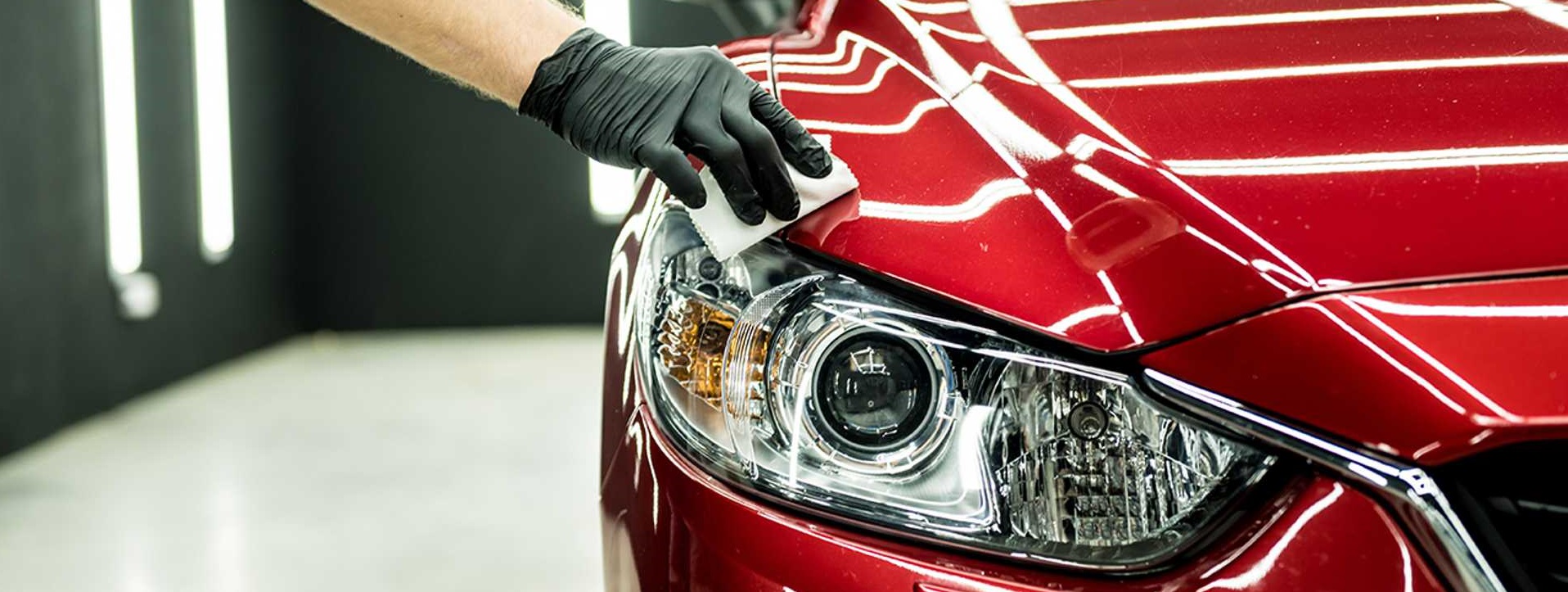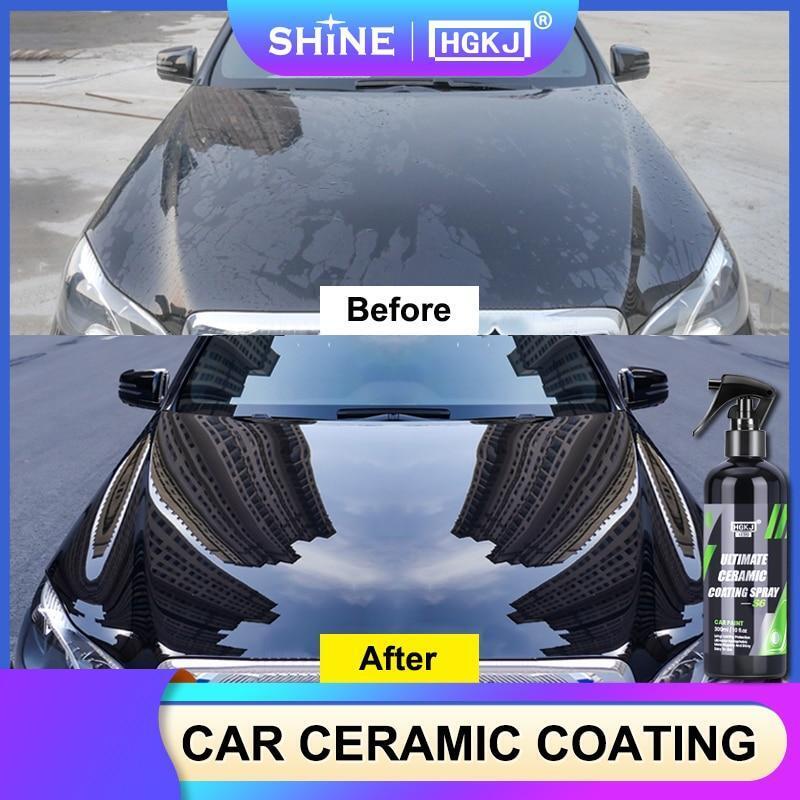How to get the most out of Ceramic Coating Newark for long-lasting shine
Checking out the Scientific Research Behind Car Ceramic Coating and Its Safety Properties
The scientific research of car ceramic coating provides a fascinating research study in innovative automotive defense. Composed mostly of silicon dioxide and polymers, these finishes develop a durable bond with vehicle paint. This interaction improves durability against ecological hazards while offering hydrophobic benefits. The details of how these coatings work and their long-term benefits remain less recognized. Ceramic Coating Newark. Unloading these information exposes why ceramic layers are becoming a favored selection for vehicle care
What Is Ceramic Coating?
Ceramic coating is a fluid polymer that chemically bonds to the surface of a lorry's paint. This advanced protective layer improves longevity and provides exceptional resistance to ecological elements. Unlike traditional wax or sealers, which supply short-term defense, ceramic coatings produce a long-lasting shield that can hold up against rough conditions such as UV rays, acidic contaminants, and severe weather condition. When applied correctly, the coating creates a hydrophobic surface, causing water to grain and slide off, which assists in preserving the lorry's sanitation. In addition, it uses enhanced gloss and depth to the paint, making the car appear more polished and vivid. The application procedure generally involves complete surface area preparation, including cleaning and sprucing up, to ensure peak bonding. As an outcome, ceramic coverings are becoming significantly prominent amongst car enthusiasts and those looking for to protect their investments, guaranteeing to maintain the vehicle's aesthetic allure while decreasing the frequency of maintenance.
The Make-up of Ceramic Coatings
The intricate solution of ceramic coverings mainly contains silicon dioxide (SiO2), which is originated from all-natural sources like quartz and sand. This crucial component provides the foundation for the coating's toughness and safety qualities. Along with SiO2, ceramic coatings frequently consist of different polymers and ingredients that boost adhesion, flexibility, and resistance to ecological aspects. These substances work synergistically to develop a durable obstacle versus contaminants such as dust, chemicals, and UV rays.Furthermore, some solutions include titanium dioxide (TiO2) or various other nanomaterials, which can boost the coating's hydrophobic buildings, resulting in enhanced water repellency. The specific structure can vary considerably among manufacturers, affecting efficiency and longevity. Inevitably, the mix of these components culminates in a safety layer that not just enhances the visual appeal of automobiles however likewise offers to prolong their life-span by securing the surface area from prospective damages.
How Ceramic Coatings Job
Recognizing how ceramic coverings function entails exploring their chemical composition, which adds to their safety top qualities. The application procedure is essential for attaining excellent outcomes, while longevity and toughness elements figure out the coating's performance with time. Together, these aspects highlight the advantages and efficiency of ceramic layers for vehicle security.
Chemical Make-up Explained
While lots of car owners look for resilient protection for their cars, the chemical composition of ceramic finishes plays a crucial duty in their performance. These layers mainly consist of silicon dioxide (SiO2), which is derived from all-natural minerals. This substance forms a solid bond with the vehicle's paint, developing a resilient, safety layer. Additionally, several ceramic coverings consist of titanium dioxide (TiO2), enhancing their hydrophobic residential or commercial properties and resistance to UV rays. The existence of polysiloxanes can further improve versatility and durability. Together, these aspects add to the coating's capability to fend off water, dirt, and impurities, while additionally offering a high-gloss coating. Comprehending this chemical structure assists car proprietors value the durable defense provided by ceramic finishings.
Application Refine Overview
Using ceramic finishes includes a precise procedure that assures suitable bonding and security for the car's surface. Initially, extensive cleaning and purification of the car's outside are done to remove dust, crud, and previous waxes. This step verifies that the surface area is without contaminations that might hinder attachment. Following this, the paint is frequently polished to boost clearness and get rid of any kind of flaws. When prepared, the ceramic coating is applied in tiny areas utilizing an applicator pad, enabling uniform protection. The coating is then delegated treat, developing a strong chemical bond with the surface area. Appropriate healing times and problems are critical, as they validate the coating achieves its maximum efficiency and protective high qualities.
Durability and Toughness Factors
Ceramic coatings are created to supply resilient protection through their sophisticated chemical composition, which develops a robust barrier against ecological pollutants. The resilience of these finishings is affected by aspects such as the density of the application, the high quality of the product, and the conditions under which the vehicle is revealed. Top quality ceramic finishes can last numerous years, standing up to scratches, UV rays, and chemical spots. Correct maintenance, including regular cleaning and periodic this link reapplication, can additionally enhance longevity. Furthermore, ecological elements like climate and direct exposure to contaminants can impact the lifespan of the coating. Overall, when used and kept appropriately, ceramic finishings use exceptional sturdiness, making them a preferred choice for car lovers looking for to protect their lorry's appearance.
Hydrophobic Characteristics and Water Repellency
Hydrophobic homes are a hallmark of quality car ceramic finishes, considerably enhancing the car's surface area performance. These finishes develop a molecular bond with the car's paint, leading to a surface area that repels water efficiently. When water enters into contact with a ceramic-coated surface area, it grains up and rolls off, reducing the amount of liquid that stays on the paint. This habits not only adds to a cosmetically pleasing look yet likewise minimizes the build-up of pollutants such as dirt, gunk, and blog road salts.The boosted water repellency results in easier cleansing and maintenance, as much less initiative is required to remove undesirable substances. Furthermore, the hydrophobic nature of ceramic finishings aids in stopping water spots, which can mar the coating of uncoated surface areas. In general, the incorporation of hydrophobic residential properties in ceramic layers plays an important duty in preserving the lorry's beautiful appearance while simplifying maintenance.
Defense Against Scratches and UV Damages
Car ceramic coatings use significant protection against scrapes and UV damages. The scratch resistance mechanism develops a resilient layer that soaks up impacts, while the UV shielding advantages help maintain the lorry's paint integrity with time. With each other, these functions contribute to a longer-lasting and visually appealing finish.
Scratch Resistance Device
Utilizing advanced innovation, ceramic coatings give a robust guard against scrapes and UV damage, enhancing the long life and look of vehicle surface areas. The scratch resistance system of these coatings is associated to their unique molecular framework, which develops a durable bond with the car's paint. This bond creates a hard, safety layer that can take in effects and stand up to abrasions. Additionally, the smooth surface area of the coating lowers rubbing, making it difficult for pollutants to stick and create scrapes. The chemical structure of ceramic finishings commonly includes nanoparticles that reinforce the safety layer, more improving its resilience. Cars treated with ceramic layers exhibit markedly enhanced scrape resistance contrasted to traditional wax or sealants, ensuring an immaculate finish over time.
UV Protecting Perks
The safety top qualities of ceramic coverings extend past scratch resistance to include considerable UV securing advantages. These coverings create a robust obstacle that shows hazardous ultraviolet rays, safeguarding the vehicle's paint and underlying products. Long term direct exposure to UV radiation can lead to fading, oxidation, and wear and tear of the paint surface. By including ceramic layers, automobile owners can effectively reduce these risks, protecting the aesthetic charm and stability of their automobiles. Additionally, the UV obstructing homes add to improved long life, reducing the frequency of painting and upkeep. Inevitably, the integration of ceramic coatings provides a complete option for safeguarding vehicles from the damaging impacts of sun direct exposure, making sure a continual, dynamic appearance over time.
The Long life and Upkeep of Ceramic Coatings

Often Asked Questions
Can Ceramic Coating Be Applied to Any Kind of Lorry?
Ceramic coating can be applied to different sorts of automobiles, including autos, vehicles, and motorbikes. However, surface area preparation and compatibility with particular products are important for perfect attachment and performance of the coating.
How Much Does Ceramic Coating Usually Price?
Ceramic coating usually sets you back in between $500 and $2,000, depending upon variables such as lorry dimension, coating top quality, and expert application. The financial investment can provide long-lasting security and improve the car's appearance over time.

Is Specialist Application Necessary for Best Outcomes?
The requirement of professional application typically depends upon desired results. Specialists commonly assure proper surface area prep work and application techniques, bring about suitable bonding and long life of the coating, which may be testing for inexperienced people to attain.
Can Porcelain Coatings Be Gotten Rid Of or Repaired?
Ceramic coverings can be gotten rid of or repaired, though the procedure may require details solvents or techniques - Ceramic Coating Newark. Proper removal is important to avoid damage to the underlying surface, highlighting the importance of specialist assistance for suitable results
How Does Ceramic Coating Contrast to Traditional Wax?
The comparison in between ceramic coating and traditional wax exposes that ceramic layers supply exceptional sturdiness, boosted defense versus ecological impurities, and longer-lasting luster, while wax requires a lot more constant visit the site application and offers much less general resistance to damages.